In photography, there are two types of distortions: optical and perspective. Both result in some kind of deformation of images – some lightly and others very noticeably. While optical distortion is caused by the optical design of lenses (and is therefore often called “lens distortion”), perspective distortion is caused by the position of the camera relative to the subject or by the position of the subject within the image frame. And it is certainly important to distinguish between these types of distortions and identify them, since you will see them all quite a bit in photography. The goal of this article is to explain each distortion type in detail, with illustrations and image samples.
Optical Distortion
In photography, distortion is generally referred to an optical aberration that deforms and bends physically straight lines and makes them appear curvy in images, which is why such distortion is also commonly referred to as “curvilinear” (more on this below). Optical distortion occurs as a result of optical design, when special lens elements are used to reduce spherical and other aberrations. In short, optical distortion is a lens error.
There are three known types of optical distortion – barrel, pincushion and mustache / moustache (also known as wavy and complex). Let’s examine each in more detail, but before we do that, let’s take a look at a lens with zero distortion:
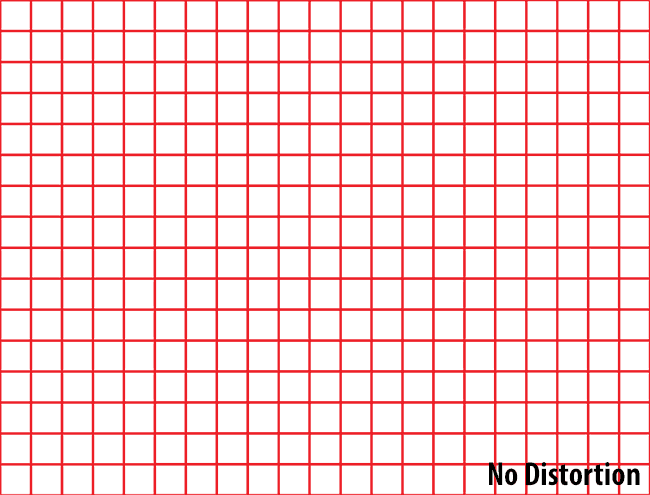
Such “perfect” lenses are very rare, since most lenses suffer from at least one kind of distortion defined below. Very good lenses have lens elements that significantly reduce distortion, where it is not noticeable to our eyes. Many zoom lenses, especially superzooms like Nikon 18-200mm VR suffer from multiple types of distortion such as barrel and pincushion at different focal lengths.
Barrel Distortion
When straight lines are curved inwards in a shape of a barrel, this type of aberration is called “barrel distortion”. Commonly seen on wide angle lenses, barrel distortion happens because the field of view of the lens is much wider than the size of the image sensor and hence it needs to be “squeezed” to fit. As a result, straight lines are visibly curved inwards, especially towards the extreme edges of the frame. Here is an example of strong barrel distortion:
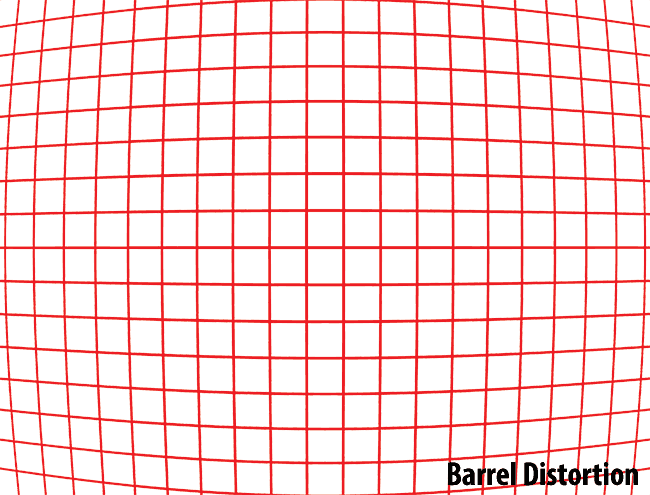
Note that the lines appear straight at the very center of the frame and only start bending away from the center. That’s because the image is the same in the optical axis (i.e. the center of the lens), but its magnification decreases towards the corners.
Barrel distortion is typically present on most wide angle prime lenses and many zoom lenses with relatively short focal lengths. The amount of distortion can vary, depending on camera to subject distance. Even standard 50mm prime lenses can potentially yield barrel distortion at close distances. Barrel distortion can be decreased significantly by using compensating optical elements, but completely eliminating such distortion is nearly impossible. Some lenses like Nikon 14-24mm f/2.8G have a number of such distortion compensating elements, which heavily increase both the weight and the size of the lens. This is why wide-angle lenses are typically bigger and heavier than standard / normal lenses.
Fixing barrel distortion is usually a pretty straightforward process. Post-processing software such as Lightroom and Photoshop, as well as many other third party tools, can easily fix barrel distortion issues, as long as the lens has a supporting profile in the database. Since every lens is different, such lens profile data must be carefully tested in a lab environment and created.
Pincushion Distortion
Pincushion distortion is the exact opposite of barrel distortion – straight lines are curved outwards from the center. This type of distortion is commonly seen on telephoto lenses, and it occurs due to image magnification increasing towards the edges of the frame from the optical axis. This time, the field of view is smaller than the size of the image sensor and it thus needs to be “stretched” to fit. As a result, straight lines appear to be pulled upwards in the corners, as seen below:
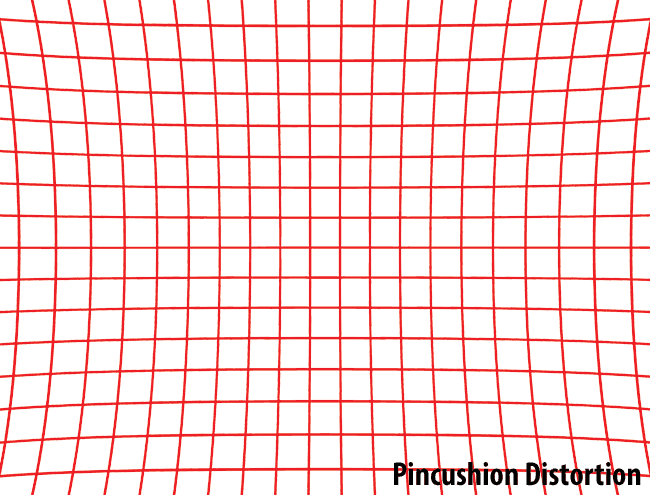
Pincushion distortion is also a very common aberration, especially on zoom lenses. Expensive super telephoto prime lenses have compensating elements that can significantly reduce pincushion distortion to negligible levels, but most consumer and even pro-level zoom lenses like Nikon 80-400mm VR suffer from pincushion distortion. In fact, pincushion distortion can be very heavy on consumer-grade lenses, something that you will quickly notice in images.
It is important to note that most zoom lenses that go from wide angle to standard or telephoto focal lengths typically suffer from barrel distortion at the shortest focal lengths, which gradually transitions to pincushion distortion towards the longest end. A good example of such behavior is the Nikon 18-300mm VR, which starts out with strong barrel distortion at 18mm, then quickly switches to pincushion distortion at 28mm and stays that way till 300mm.
Just like barrel distortion, pincushion distortion can also be easily fixed in post-processing software like Lightroom and Photoshop. Lens profiles built into Lightroom and Camera RAW have the capability to completely eliminate it with a single click.
Mustache Distortion
The nastiest of the radial distortion types is mustache distortion, which I sometimes call “wavy” distortion. It is basically a combination of the barrel distortion and pincushion distortion. Straight lines appear curved inwards towards the center of the frame, then curve outwards at the extreme corners, as shown below:
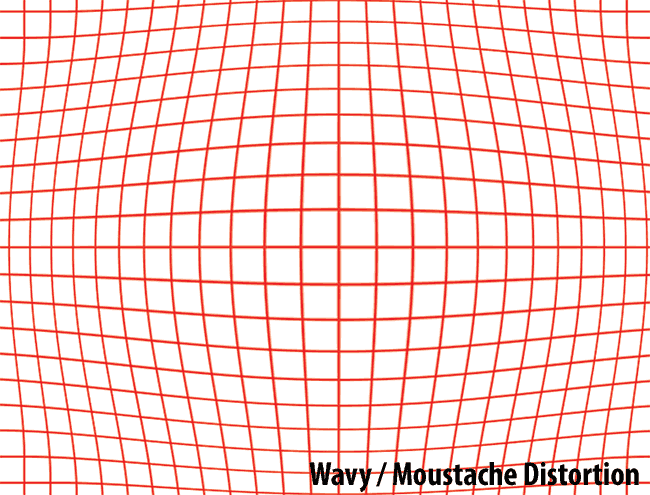
This is the reason why mustache distortion is often referred to as “complex” distortion, because its characteristics are indeed complex and can be quite painful to deal with. While this type of distortion can be potentially fixed, it often requires specialized software. You cannot just use the built-in tools in Lightroom and Photoshop, unless a specific lens profile is already built to combat such distortion. If you attempt to deal with such distortion as barrel-type, you will end up curving the extreme corners a lot more. And if you attempt to compensate for pincushion distortion, you will end up curving it for even stronger barrel distortion towards the center.
A number of older lenses, as well as some modern lenses have mustache distortion. A good example of this is the Nikon 18-35mm f/3.5-4.5D lens, which shows a rather nasty case of a mustache distortion.
Rectilinear vs Curvilinear Lenses
Some lenses are optically designed to be “rectilinear” (like the Nikon 14mm f/2.8D and the Canon EF 14mm f/2.8L II USM), where they yield straight lines without bending them (resembling human vision), while other lenses like “fisheye” lenses are designed to be “curvilinear”. Rectilinear lenses generally stretch objects to make them appear straight, especially towards the edges of the frame. Curvilinear lenses, on the other hand, do not stretch anything, but they heavily distort images by curving straight lines (like in door peepholes). Take a look at the following image samples that show both rectilinear and curvilinear lens effects:

As you can see, the fence on the curvilinear lens sample appears unnaturally curved – that’s because I photographed it using a fisheye (curvilinear) lens. The image on the right is what you would see from a rectilinear lens – the fence looks straight and natural, just like you would see it with your eyes. The size of the fence appearing large in the front of the frame and getting smaller at longer distances is perspective distortion (see below), which has nothing to do with optical distortion.
Rectilinear and curvilinear lens verbiage is typically applied only to wide-angle lenses.
Perspective Distortion
So far we have been only talking about optical distortions. Another distortion type that is often seen in images is perspective distortion. Unlike optical distortion, it has nothing to do with lens optics and thus, it is not a lens error. When projecting three dimensional space into a two dimensional image, if the subject is too close to the camera, it can appear disproportionately large or distorted when compared to the objects in the background. This is a very normal occurrence and something you can easily see with your own eyes. If you take a smaller object like your mobile phone, then bring it very close to your eyes, it will appear large relative to say your big screen TV in the background (and the farther your phone is from your TV, the smaller the TV will appear relative to your phone). The same thing can happen when photographing any subject, including people.
For example, if you photograph a person with an ultra wide angle lens up close, their nose, eyes and lips can appear unrealistically large, while their ears can look extremely small or even completely disappear from the image. Take a look at the following photos of a subject captured with a wide-angle lens at very close distances:
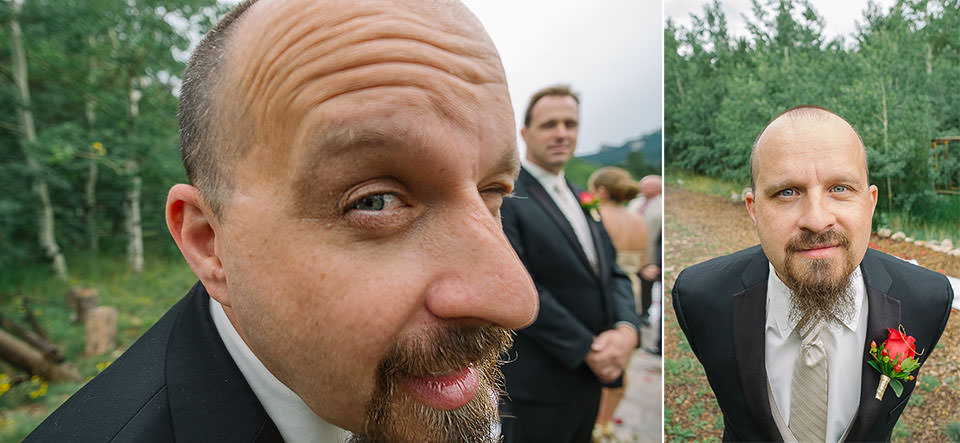
Right: Moving slightly away and centering the subject’s head fixed the issue, but look at what it did to the subject’s body – the shoulders look enormous compared to the rest of the body.
Look at the size of his head on the left photograph – it appears disproportionately large relative to his body. His eyes, nose and lips are very much enlarged, while his ears are dwarfed.
This is the part that seems to confuse a lot of photographers – the relationship (or lack thereof) of focal length to perspective distortion. You might hear some photographers say that one should use longer focal lengths to photograph people, or they will get distorted due to the lens’ short focal length. This is a mostly false statement, because lenses have no perspective. Other than fisheye lenses, all lenses have the same perspective – it is the camera to subject distance that determines perspective, not the focal length. There is an illusion of different perspective of lenses, because with long focal lengths you have to stand further away from the subject to frame them the same way. If you were to stand at the same distance, the subject would appear exactly the same! So if you take a 50mm lens and an 85mm lens, there is no difference in perspective between the two, as long as you stand in the same spot and keep the subject to camera distance the same. Yes, the subject would certainly appear smaller with the 50mm lens due to shorter focal length / wider field of view, but the perspective and proportions would be the same on both. So the point of longer focal length lenses in such cases, is the possibility to enlarge the subject in the frame, while keeping normal perspective. Telephoto lenses do not magically fix perspective distortion – they force you to move back from the subject, which is what changes the perspective.
Take a look at the following photograph of a red car:
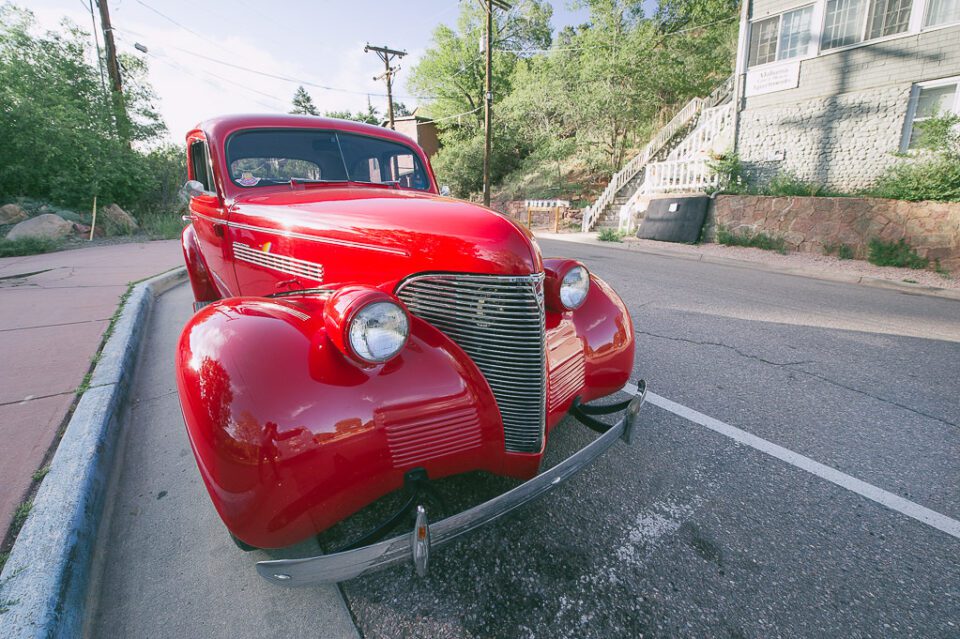
The car looks completely distorted, because I stood very close to it and photographed it with a wide-angle lens (Nikon 14-24mm). Note that the left part of the car looks disproportionately big – even the left light looks about 50% bigger than the one on the right, although you know that they are both the same in size. The car is occupying the majority of the frame and everything in the background looks relatively small. If I used a normal lens and stood in the same spot, I would have ended up with only a part of the car filling the whole frame. Yet, if I were to crop both images for the same field of view by heavily cropping the wide angle shot, the perspective distortion effect would be the same on both.
Here is another example of perspective distortion:
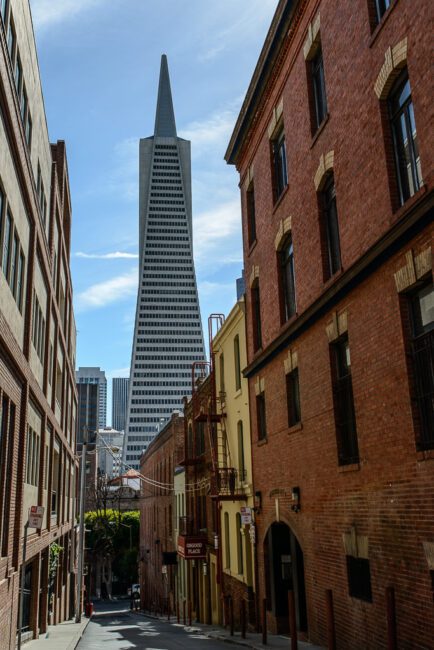
In this image of a downtown San Francisco street, the four story buildings to the left and the right look larger than the 48 story Transamerica Pyramid (the long building in the distance), when in fact they are much smaller if you were to put them side by side. Because I used a wide angle lens, I was able to show the front buildings much bigger than they really are.
The above examples of perspective distortion are known as “wide-angle”, or “extension” distortion. There is another kind of perspective distortion, which is the opposite of wide-angle distortion – it is called “telephoto” or “compression” distortion. Compression distortion is only possible with telephoto lenses, because it requires the photographer to stay at a long distance relative to the subject, which essentially makes very distant objects appear larger than they are when compared to “normal” perspective.
Lastly, there is also the case of converging lines. When the camera sensor is not perfectly parallel to the photographed object such as a building, it produces an image that at first might seem unnatural, due to its “leaning” effect, as shown below:

However, this is a perfectly natural perspective with no distortion, because your eyes would see this exactly the same way. Lens manufacturers offer “perspective control” or “tilt-shift” lenses to deal with this particular situation, but the result actually turns out unnatural, since that’s not how it looks in real life when we look up. Take a look at the below examples of before (left) and after (right) perspective control change:
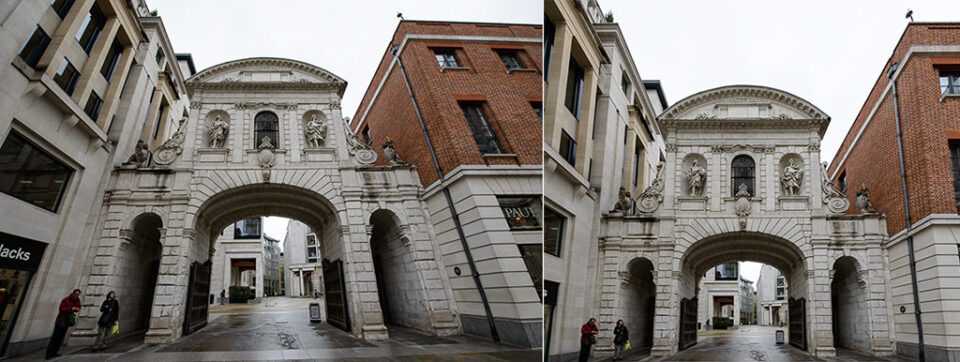
The image on the left is how you would see it with your eyes if you stood there, while the image on the right is what a perspective control / tilt-shift lens would do to the image, after it is aligned to the building.
Here are a couple of more examples of converging lines, where one part of the image appears much larger than the other simply because it is closer:
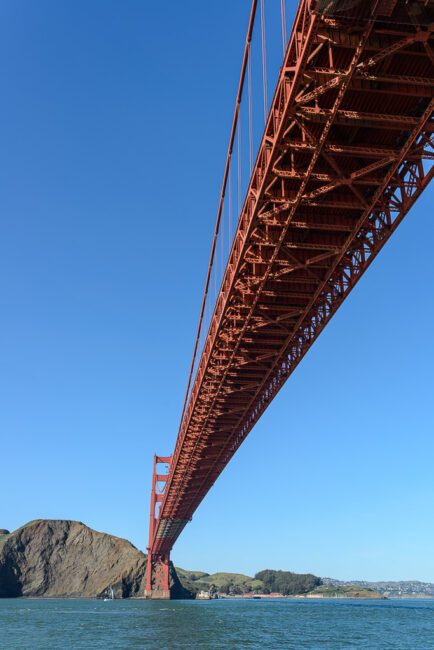

Again, none of these are a result of distortion – that’s a natural perspective!
And lastly, one more example of perspective distortion involving people:
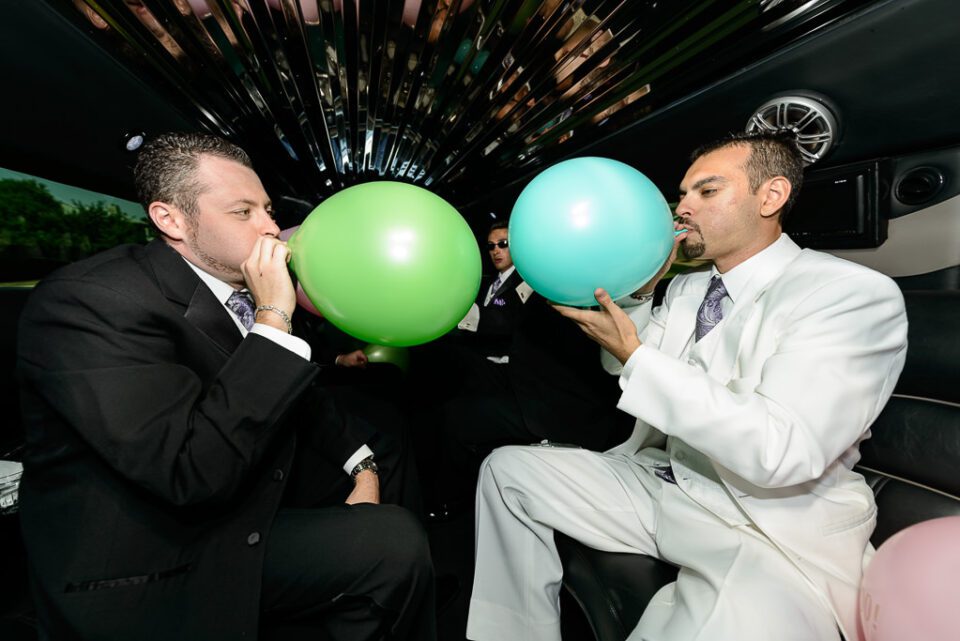
Note how the balloons in the center of the frame appear natural, while the heads of the groom and the best man look egg-shaped. This is a direct result of using an ultra-wide angle lens at a very close distance and badly placing the subjects. If both sat back to back and inflated balloons in the opposite directions, their heads would have looked pretty normal being in the center, while the balloons would have been egg-shaped.
I hope this article clarifies differences between the different types of distortions.
